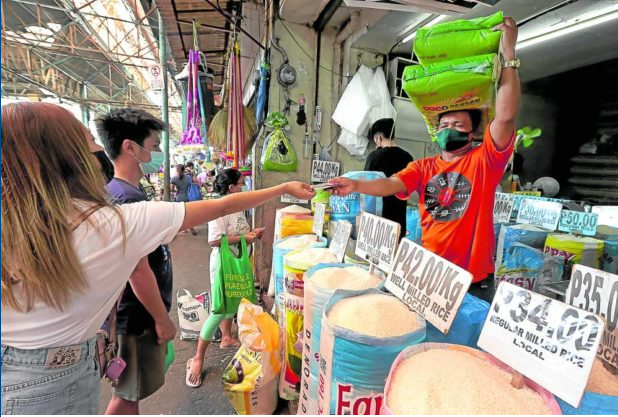P20 per kilo rice possible as early as 2023 – DAR
MANILA, Philippines — The Department of Agrarian Reform (DAR) has crafted a strategy to realize President-elect Ferdinand Marcos Jr.’s goal of selling rice to consumers at much cheaper prices than the current average of P39 a kilo.
During the campaign, Marcos Jr. vowed to bring down the price of rice to P20 a kilo, which agricultural stakeholders claimed was impossible because the cost of producing, marketing and shipping the staple alone has substantially increased.
But Agrarian Reform Secretary Bernie Cruz on Monday said it was possible for consumers to buy a kilo of rice at P20 as early as next year.
“Once we discuss the details with the president-elect, we will have the guidelines within the next six months. Perhaps we’ll be able to achieve this within the first quarter of next year,” Cruz said in a mix of Filipino and English during a press briefing on Monday.
The DAR is pitching to the incoming administration the Programang Benteng Bigas sa Mamamayan (PBBM), an initiative that aims to consolidate small farm lots into mega-farms for rice production.
Cruz described the mega farm as a cluster of contiguous farms that are consolidated to form a sizable plantation capable of producing large volumes.
A mega farm, according to the DAR, should be comprised of a production core or area with at least 50 hectares of agrarian reform lands that are contiguous or near one another.
It said infrastructure projects and facilities would be provided to support production, postharvest, processing and marketing, including farm-to-market roads and bridges, irrigation, potable water supply, warehouses and storage facilities, greenhouses, and inputs and product distribution stations.
Among the many models that can be adopted by beneficiaries include a local or foreign investor-led production core, joint venture or lease agreement or management contract.
The PBBM will initially start with 150,000 ha of rice land, fully mechanized, under the coverage of the Comprehensive Agrarian Reform Program.
This area can yield 23 million cavans of rice, or enough to feed nine million Filipinos and benefit about 100,000 agrarian reform beneficiaries and small farmers.
“From the studies we conducted in the mega-farms project, we found out that not only is the P20-a-kilo-rice achievable, it is also profitable for our agrarian reform beneficiaries,” Cruz said.
The DAR has estimated each agrarian beneficiary would earn P76,501 a year or P6,375 a month.
The agency, however, did not disclose other details about PBBM.
It only said the objective was to reduce the production cost, cut the layers of rice trading by selling directly to consumers, and that it would be implemented nationwide.
“This requires political will because the DAR and national government agencies need to work along with local governments to make it happen,” Cruz said.
Losing proposition
But Federation of Free Farmers Cooperatives national manager Raul Montemayor said the DAR’s plan would only make farmers end up losing more, especially if the farm-gate price — or the selling price between a trader and a farmer — is further reduced.
Montemayor said if a kilo of rice would be sold at P20, the farm-gate price would have to be about P10 a kilo.
As a rule of thumb, the retail price of rice is at least double the farm-gate price of palay (unhusked rice), which is currently P19 a kilo.
“This will definitely be a losing proposition for farmers,” Montemayor told the Inquirer in a Viber message.
“On the other hand, if the farm-gate price of palay is set to the NFA (National Food Authority) buying price of P19 (a kilo) so that farmers earn a profit, the selling price of rice should be around P38, and if you sell at P20 only, then the government will have to subsidize the P18 difference per kilo,” he said.
Montemayor added that if palay would be bought at P19 a kilo, the cost of palay alone to produce a kilo of rice would already reach P30.78. A kilo of rice is produced from 1.62 kilos of palay, he added.
“Then you have to add storage, freight, marketing, profit margins of traders, etc. until the retail price reaches around P38 a kilo. So, reducing marketing channels and cost will not be enough to bring rice prices to as low as P20,” he said.
“The DAR should focus on finishing the agrarian reform program and awarding the titles to the farmers so that the farmers can concentrate on producing rice at the cheapest possible price,” Montemayor said.
Price hike plea
Meanwhile, Trade Secretary Ramon Lopez said any price hike on products under the suggested retail price, including canned meat, would likely be made under the incoming Marcos administration, given the time it takes to review the request of manufacturers.
Canned meat producers have sought an 8-percent increase in the government-set suggested retail price (SRP) of their covered products, noting that the adjustment allowed earlier in May was not enough to address their higher costs of production.
“If and when requests come, these will be reviewed. There’s a review and verification process, [as well as a] one-on-one discussion of findings with requesting manufacturers to ensure consumer protection at all times,” said Lopez, who ends his term this month. “[The] whole process usually takes about four to six weeks.”
Asked if the decision would likely be made by the next trade secretary, Alfredo Pascual, Lopez said: “Yes. Based on the process involved.”
Jerome Ong, vice president of the Philippine Association of Meat Processors Inc., recently told the Inquirer that they had initially asked for a 10 to 12 percent rise in the SRP, but only 3 to 4 percent was approved in May.
The group now wants the government to give the rest of the increase it asked for.

